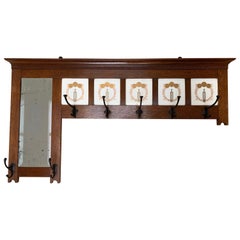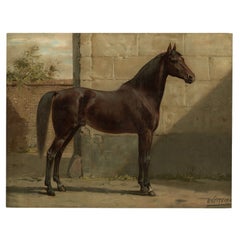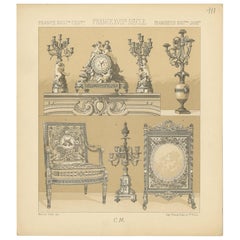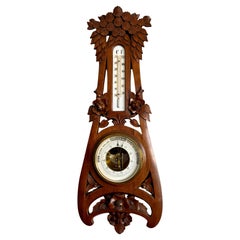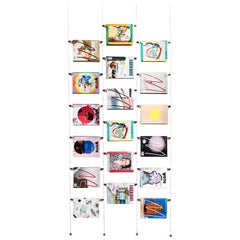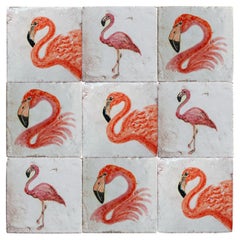Benelux - Decorative Art
to
4,858
5,639
11,242
5,510
5,597
33
9
Height
to
Width
to
108
27
19
15
12
11
7
7
6
4
3
2
1
1
1,201
3,528
868
42
393
141
76
12
1
8
7
3
10
27
48
10
9
5,259
155
153
120
61
651
229
124
74
48
5,639
5,626
5,629
79
75
58
58
32
Item Ships From: Benelux
circa 1910 Arts & Crafts Oak Wall Coat Rack, Beveled Mirror & Hand Painted Tiles
Located in Lisse, NL
Large size, great shape and excellent condition antique coat rack.
If you are looking for a stylish and practical coat rack in the Arts & Crafts style then this period piece could be perfect for you. It is truly stylish, entirely original and, as you can see in our images, it is in very good condition. This quality antique is handcrafted from solid oak and it comes with the inlaid, hand painted and glazed tiles. These tiles are extra special, because on top of the glazing are unique, gilt and stylized flower motifs. This luxurious and colorful coat rack also comes with all the original and aesthetically beautiful hooks...
Category
Early 20th Century European Arts and Crafts Benelux - Decorative Art
Materials
Majolica, Mirror, Oak
Antique Horse Print of the East Prussian Horse, 1898
Located in Langweer, NL
Description: Antique print, untitled. Antique print, titled: 'Het Oost-Pruissische Paard.' - An East Prussian Horse. This is an original lithograph (inclusing text pages!) of a horse...
Category
1890s Antique Benelux - Decorative Art
Materials
Paper
$897 Sale Price
20% Off
Pl 111 Antique Print of French 18th Century Decorative Objects by Racinet
Located in Langweer, NL
Antique print titled 'France XVIIIth Cent - France XVIIIe, Siecle - Frankreich XVIIItes Jahr'. Chromolithograph of French 18th century decorative. This print originates from 'Le Cost...
Category
Late 19th Century Antique Benelux - Decorative Art
Materials
Paper
$94 Sale Price
20% Off
Large Arts & Crafts Hand-Carved Nutwood Barometer with Thermometer, Early 1900s
Located in Lisse, NL
This rare and decorative early 20th-century Arts & Crafts wall barometer and thermometer is a striking testament to Dutch craftsmanship. Hand-carved from a single solid piece of rich...
Category
Early 20th Century European Arts and Crafts Benelux - Decorative Art
Materials
Metal, Brass
Cover Curtain, a Room Separator/Bookshelf, 4 Lines+18 Rulers by Vantot
By Vantot
Located in Breda, Noord-Brabant
Please note the price is calculated for a set of (4 lines + 18 rulers) as in the images.
Cover curtain, a spatial room divider meets a bookshelf. Showcasing your favorite book covers as a rhythmic mood board in space. Cover curtain works as an instrument with endless possibilities. Created small bookshelf...
Category
21st Century and Contemporary Dutch Art Deco Benelux - Decorative Art
Materials
Aluminum
Variety of Flamingo Majolica Tiles, Handmade in Italy
Located in Rijssen, NL
Gorgeous handpainted tiles with 3 different images of a pink flamingo (Phoenicopterus roseus Pallas). The tiles are hand painted and handmade in Italy...
Category
2010s European Other Benelux - Decorative Art
Materials
Ceramic, Majolica
Antique Costume Print of a Female in Jalapa by Wahlen, 1843
Located in Langweer, NL
Antique costume print titled 'Femme de Jalapa'. Original antique print of a female in Jalapa. This print originates from 'Moeurs, usages et costumes de tous les peuples du monde' by ...
Category
Mid-19th Century Antique Benelux - Decorative Art
Materials
Paper
$94 Sale Price
20% Off
MidCentury Modern Italian Set of 4, Art Deco Style Large Alabaster Wall Sconces
Located in Lisse, NL
Last 4 of an original set of 16 wall fixtures.
Set of four really large and great looking, half-moon shape, easy to mount and beautifully handcrafted alabaster wall lights.
In all ...
Category
Mid-20th Century Italian Art Deco Benelux - Decorative Art
Materials
Alabaster, Metal
Antique Print of Sumo Wrestlers at Yokohama in Japan, 1856
Located in Langweer, NL
Antique print titled ‘Wrestlers at Yokuhama’. Lithograph of wrestlers at Yokohama, Japan. This print originates from 'Narrative of the expedition of an American squadron to the China...
Category
19th Century Antique Benelux - Decorative Art
Materials
Paper
$226 Sale Price
20% Off
Antique Bird Print of a Weka by Severeyns 'c.1850'
Located in Langweer, NL
Antique bird print titled 'Gallirallus Fuscus'. Rare antique print of a weka (also known as the Maori hen or woodhen). Published by G. Severeyns, circa 1850.
Category
Mid-19th Century Antique Benelux - Decorative Art
Materials
Paper
$141 Sale Price
20% Off
Antique Print of an Elephant Hunt by D'Urville (1853)
Located in Langweer, NL
Antique print titled 'Chasse aux Éléphants'. Original print of an elephant hunt. This print originates from volume 1 of 'Voyage Autour du Monde' by Comte-Amiral Dumont D'Urville.
Category
Mid-19th Century Antique Benelux - Decorative Art
Materials
Paper
$236 Sale Price
20% Off
Original Antique Bird Engraving of a Green Macaw
By Georges-Louis Leclerc, Comte de Buffon
Located in Langweer, NL
Antique bird print titled 'L'Ara Vert'. Old bird engraving of a green macaw. This print originates from 'Histoire Naturelle, générale et particulière, avec la description du Cabinet ...
Category
Late 18th Century Antique Benelux - Decorative Art
Materials
Paper
$245 Sale Price
20% Off
Set of 8 Antique Mycology Prints of Various Fungi by Barla, circa 1890
Located in Langweer, NL
Set of eight antique mycology prints depicting various fungi / mushrooms. These prints originate from 'Flore mycologique illustrée: les champignons des Alpes-Maritimes' by J.B. Barla.
Category
Late 19th Century Antique Benelux - Decorative Art
Materials
Paper
$614 Sale Price / set
20% Off
Pl. 2 Antique Print of Egyptian Ornaments by Racinet 'circa 1890'
Located in Langweer, NL
Antique print titled 'Egyptian- Égyptien - Aegyptisch'. Chromolithograph of Egyptian ornaments and decorative arts. This print originates from 'l'Orn...
Category
Late 19th Century Antique Benelux - Decorative Art
Materials
Paper
$141 Sale Price
20% Off
Antique Print of a Navarrin Horse by Fessard, 1819
Located in Langweer, NL
Antique print titled 'Cheval Navarrois'. Copper engraving of a Cheval Navarrin, also called Navarin, Navarrois, Tarbais, Tarbésan or Bigourdin, an extinct breed of light saddle-horse...
Category
Early 19th Century Antique Benelux - Decorative Art
Materials
Paper
$113 Sale Price
20% Off
Antique Print of the Vegetable Marrow
Located in Langweer, NL
Antique print titled 'The Vegetable Marrow'. This print originates from 'Transactions of the Horticultural Society of London' published circa 1835.
In Transactions of the Horticul...
Category
Mid-19th Century Antique Benelux - Decorative Art
Materials
Paper
$179 Sale Price
20% Off
Antique Print of Various Marine Life by Meyer 'c.1905'
Located in Langweer, NL
Antique print titled 'Entwickelungsgeschichte I'. Original antique print of various marine life. This print originates from the 6th edition of Meyers Konversations-Lexikon, published...
Category
Early 20th Century Benelux - Decorative Art
Materials
Paper
$141 Sale Price
20% Off
Antique Print of the Siege of Gaeta 'circa 1860'
Located in Langweer, NL
Antique print titled 'Prise de Gaëte'. Steel engraving of the Siege of Gaeta (1806). This print originates from 'Album de Vingt Batailles de la Révolution et ...
Category
Mid-19th Century Antique Benelux - Decorative Art
Materials
Paper
$165 Sale Price
20% Off
Herend Hungary Porcelain "Chinese Bouquet Apponyi Green" Wall Decoration Plates
By Herend
Located in Delft, NL
Herend Hungary Porcelain "Chinese Bouquet Apponyi Green" Wall Decoration Plates
Herend Hungary porcelain plates for as decoration to hang on the wall, with openwork edges
Beautiful...
Category
20th Century Hungarian Benelux - Decorative Art
Materials
Porcelain
Three Antique Architecture Prints of Various Building Plans and Facades, c.1770
Located in Langweer, NL
"Architectural Elegance: Neoclassical Facades and Floor Plans from 'Recueil Élémentaire d’Architecture' by Jean-Francois de Neufforge" offers a captivating glimpse into the rich heri...
Category
Late 18th Century French Antique Benelux - Decorative Art
Materials
Paper
Set of 16 Blue and White Delft Tiles with Animals and Figures, 18th Century
Located in AMSTERDAM, NH
Germany
Ansbach
18th century
A set of 16 blue and white, with manganese tint, tiles with decorations of animals and figures.
Very fine painting and much detail in the animals and fi...
Category
Mid-18th Century German Baroque Antique Benelux - Decorative Art
Materials
Ceramic, Faience, Majolica
Beautiful Watercolored Work of Roses of an Unknown Artist, c1880
Located in Langweer, NL
A very decorative work of an unknown artist, estimated to be made in the late 19th century.
We also offer thousands of antique prints covering fields of interest as diverse as archi...
Category
19th Century Antique Benelux - Decorative Art
Materials
Paper
$311 Sale Price
20% Off
Antique Print of New York, 1881
Located in Langweer, NL
Antique print titled 'New York aus der Vogelschau'. Handcolored wood engraving of New York. This print originates from 'Ïllustrierte Zeitung' published in 1881.
Category
Late 19th Century Antique Benelux - Decorative Art
Materials
Paper
$236 Sale Price
20% Off
Antique Print of Various Medals of the Turkish Empire, 1843
Located in Langweer, NL
Plate 42: 'Turksch Keizerrijk. Keizerlijke Orde van de Halve Maan - Orde van Nichen Istehar of van Verdienste.' (Turkish Empire. Order of the Crescent - Order of Glory). The Imperial Order of the Crescent was a chivalric order of the Ottoman Empire. It was instituted in 1799 by Sultan Selim...
Category
Mid-19th Century Antique Benelux - Decorative Art
Materials
Paper
$165 Sale Price
20% Off
Antique Bird Print of a Black Rooster by Fessard, 1819
Located in Langweer, NL
Antique print titled 'Coq d'Inde Noir'. Copper engraving of a black rooster. This print originates from 'Handboek der genees- en verloskunde van het vee ...
Category
Early 19th Century Antique Benelux - Decorative Art
Materials
Paper
$113 Sale Price
20% Off
Set of 4 Vintage Prints of Pine Trees and Pine Cones, Cedar of Lebanon
Located in Langweer, NL
Antique print of various pine trees and pine cones titled 'Cones and Leaves of Cypress - Cones and Needles of Spruce - Cones and Needles of Cedar of Lebanon...
Category
Early 20th Century Benelux - Decorative Art
Materials
Paper
$415 Sale Price / set
20% Off
Antique Bird Print of the Eurasian Hobby Falcon by Von Wright '1929'
Located in Langweer, NL
The antique bird print titled 'Falco Subbuteo' is a historical depiction of the Eurasian hobby falcon. This print is sourced from 'Svenska Foglar Efter Naturen Och Pa Stenritade,' a work by Magnus von Wright.
**Key Features of the Print:**
1. **Ornithological Illustration**: The print is an ornithological illustration, showcasing the Eurasian hobby falcon (Falco subbuteo) in remarkable detail. It likely captures the bird's distinctive features, plumage, and anatomical characteristics.
2. **Scientific Accuracy**: Ornithological prints of this nature were created with a strong emphasis on scientific accuracy. The artist would have aimed to provide a true-to-life representation of the bird species.
3. **Natural History Context**: The print is part of 'Svenska Foglar Efter Naturen Och Pa Stenritade,' indicating its role in documenting and studying the natural history of birds, particularly those found in Sweden.
4. **Magnus von Wright**: Magnus von Wright, along with his brothers, was known for his contributions to ornithology through art. The von Wright brothers...
Category
Early 20th Century Benelux - Decorative Art
Materials
Paper
$141 Sale Price
20% Off
Rare Antique Engraving of a Beautiful Woman of Eaoo in Tonga, by Cook, 1803
By Cook
Located in Langweer, NL
Antique print titled 'Eene Vrouw van Eaoo'. Antique print depiciting a native woman from Eaoo, Friendly Islands, Pacific. Originates from 'Reizen Rondom de Waereld door James Cook (....
Category
19th Century Antique Benelux - Decorative Art
Materials
Paper
$274 Sale Price
20% Off
Antique Bird Print of a Lap Owl
Located in Langweer, NL
Antique bird print titled 'Lap Owl'. Original old bird print of a lap owl. This print originates from 'A history of the birds of Europe,...
Category
Mid-19th Century Antique Benelux - Decorative Art
Materials
Paper
$160 Sale Price
20% Off
Set of Four Antique Archicture Prints of Various Building Plans and Facades
Located in Langweer, NL
Set of four architecture prints depicting various building facades and plans. The prints state 'Toises', which was one of the fundamen...
Category
Late 18th Century Antique Benelux - Decorative Art
Materials
Paper
Late 19th Century Great Quality Needlework Mary and Child Jesus Religious Banner
Located in Lisse, NL
Handcrafted "Our Lady of the Sacred Heart, pray for us" banner.
It must have taken a highly skilled seamstress an enormous amount of time to create this impressive religious banner....
Category
19th Century Dutch Gothic Revival Antique Benelux - Decorative Art
Materials
Linen, Silk, Velvet, Oak
Object MO6 by Studio Zero Milano, 1970
By Studio Zero
Located in Weesp, NL
Studio Zero Milano Object MO6, 1970
Giorgio Tonti, Milan, 1936
Abstract composition "multipli" on the plate, label marked G. Tonti, Studio Zero, Mi...
Category
1970s Italian Mid-Century Modern Vintage Benelux - Decorative Art
Materials
Aluminum
Antique Print of Mastino II della Scala, Lord of Verona, by Bonnard, 1860
Located in Langweer, NL
Antique print titled ‘Mastino II, XIV Siecle.’ Original antique print of Mastino II della Scala, Lord of Verona, Italy. This print originates from 'Costumes historiques de femmes du ...
Category
Mid-19th Century Antique Benelux - Decorative Art
Materials
Paper
$94 Sale Price
20% Off
Antique Mycology Print of the Suillus Luteus, C.1860
By Elias Magnus Fries
Located in Langweer, NL
Antique mycology print titled 'Boletus Luteus'. Old print of the Suillus luteus. Suillus luteus is a bolete fungus, and the type species of the genus Suillus. A common fungus native ...
Category
19th Century Antique Benelux - Decorative Art
Materials
Paper
$132 Sale Price
20% Off
19th Century Caricature Playing Cards
Located in Delft, NL
32 pieces caricature playing cards, 19th century
19th century Caricature playing cards printed on one page
32 pieces hand colored
Framed and behind glass
The size is 68 cm x 80 cm...
Category
19th Century British Antique Benelux - Decorative Art
Materials
Paper
Antique Print of the City of Nice in Southern France, 1856
Located in Langweer, NL
Antique print titled 'Nice, Nizza'. View of the city of Nice, France. This print originates from 'Italy, Classical, Historical and Picturesque' by Camillo Mapei.
Artists and Engra...
Category
19th Century Antique Benelux - Decorative Art
Materials
Paper
$179 Sale Price
20% Off
Collection of 57 Decorative Butterfly Taxidermy Cases.Real Butterfly Art Display
Located in Leuven , BE
In the past, amateur entomologists and scientists often collected butterflies. For example, in the Victorian age, it was a wide spread educational leisure activity. This restored and pest-free old collection has about 4.500 butterflies that have been dried and pinned. Thirty percent of the species are European. The origin of the remaining specimens lies, inter alia, in Africa, Madagascar, Formosa, India...
Category
Late 20th Century Benelux - Decorative Art
Materials
Organic Material
Royal Delft Blue Plate by Porceleyne Fles
By Royal Delft
Located in Waddinxveen, ZH
Delft Blue sinces 1653
Royal Delft has been creating high-quality Delft Blue since 1653. This age-old craft is passed on from generation to generation and iconic masterpieces are sti...
Category
1970s Dutch Dutch Colonial Vintage Benelux - Decorative Art
Materials
Porcelain
Antique Print of Eggplant, Okra, Squash and Radish by Faguet, 1871
Located in Langweer, NL
Beautiful large antique print depicting various vegetables. Depicted are an eggplant, okra, squash/pumpkin and radish. This print originates from 'Album Vilmorin' published in Paris,...
Category
Late 19th Century French Antique Benelux - Decorative Art
Materials
Paper
$531 Sale Price
25% Off
Dutch Delft Porceleyne Fles Wall Plate, 1960
By De Koninklijke Porceleyne Fles
Located in Delft, NL
Dutch Delft Porceleyne Fles wall plate, 1960
A large wall plate with a floral and peacock decor. The wall plate with craquelure and on the back the mark of The Royal Porceleyne Fles...
Category
20th Century Dutch Benelux - Decorative Art
Materials
Earthenware
Antique Print of a Venetian Senator, 15th Century, by Bonnard, 1860
Located in Langweer, NL
Antique print titled ‘Senateur Venitien, XVe Siecle.’ Original antique print of a Venetian senator, 15th century. This print originates from 'Costumes historiques de femmes du XIII, ...
Category
Mid-19th Century Antique Benelux - Decorative Art
Materials
Paper
$94 Sale Price
20% Off
Original Antique Print of a Lioness and Lion Cubs by Ridinger
Located in Langweer, NL
Beautiful original old print of a lioness and lion cubs. This print originates from Dr. Johann Schreber's 'Die Saugthiere in Abbildungen nach der Natur'(Mammals in Pictures after Nature). Drawn by Johann Elias Ridinger (1698–1767).
Johann Christian Daniel von Schreber (1739–1810) was appointed professor of materia medica at the University of Erlangen in 1769. In 1774, he began writing a multivolume set of books entitled Die Säugethiere in Abbildungen nach der Natur mit Beschreibungen, which focused on the mammals of the world. Many of the animals included were given a scientific name for the first time, following the binomial system of Carl Linnaeus. From 1791 until his death in 1810, he was the president of the German Academy of Sciences Leopoldina. He was elected a member of the Royal Swedish...
Category
Late 18th Century Antique Benelux - Decorative Art
Materials
Paper
$274 Sale Price
20% Off
Set of Four Antique Architecture Prints of Palace Facades by Neufforge
Located in Langweer, NL
Set of four architecture prints depicting various palace facades. These prints originate from 'Recueil Élémentaire d’Architecture' by ...
Category
Late 18th Century Antique Benelux - Decorative Art
Materials
Paper
Antique Genealogy Print of the 'De Kessel' Family by Herckenrode, 1862
Located in Langweer, NL
Antique print titled 'De Kessel (moderne)'. Coats of arms / family crest of the 'De Kessel' family. This print originates from 'Complement au nobiliaire des Pays-Bas et du comte de B...
Category
19th Century Antique Benelux - Decorative Art
Materials
Paper
$122 Sale Price / item
20% Off
Antique View of the City of Nice on the South-Coast of France, c.1865
Located in Langweer, NL
Antique print titled 'Nice, vue prise de la hauteur de l'ancien Château'. Original antique print of the city of Nice, France. This print originates from 'Nice Et Savoie, Sites Pittor...
Category
19th Century Antique Benelux - Decorative Art
Materials
Paper
$226 Sale Price
20% Off
Antique Dutch Dark Blue Glazed Ceramic Tiles
Located in Rijssen, NL
This is an amazing set of dark blue handmade tiles of a Dutch scenery of sailing ships. With 6 different stylized designs. These tiles would be charming displayed on easels, framed or incorporated into a custom tile design.
Please note that the price is for a set of 6 tiles...
Category
20th Century Belgian Folk Art Benelux - Decorative Art
Materials
Ceramic
Maurice Brailly Hunting Dog Birds Vintage Graphics in Color 1972
Located in Poperinge, BE
Vintage graphic of a hunting dog in a dark oak frame, graphic art image of an English hunting dog pointing at birds, signed and dated lower left in print, Maurice Brailly 1972, Franc...
Category
1970s French Vintage Benelux - Decorative Art
Materials
Glass, Oak, Paper
Antique Engraving of Ancient Coins, 1773
Located in Langweer, NL
Untitled print depicting various ancient coins, illustrated with figures and animals. Originates from the first Dutch editon of an interesting travel account of Northern Africa title...
Category
18th Century Antique Benelux - Decorative Art
Materials
Paper
$113 Sale Price
20% Off
Antique Print of a Japanese Box 'Lacquer' by G. Audsley, 1882
By George Ashdown Audsley
Located in Langweer, NL
Untitled print, Section IV, plate IV. This chromolithograph depicts a beautiful Japanese box. Detailed information about this print is available on request.
This print originates ...
Category
Late 18th Century Antique Benelux - Decorative Art
Materials
Paper
$283 Sale Price
20% Off
Antique Print of a Woman from Montafon in Winter Costume, circa 1880
Located in Langweer, NL
Antique costume print titled 'Kranzjungfer (Schäppelmeiggi) aus Montafun, Voralberg'. Old print showing a woman in winter costume from Montafon. This print originates from 'Blätter f...
Category
Late 19th Century Antique Benelux - Decorative Art
Materials
Paper
$75 Sale Price
20% Off
Antique Bird Print of a Female Buzzard by Von Wright, '1929'
Located in Langweer, NL
Antique bird print titled 'Buteo Intermedius'. Old bird print depicting a female buzzard. This print originates from 'Svenska Foglar Efter Naturen Och Pa Stenritade' by Magnus von Wr...
Category
Early 20th Century Benelux - Decorative Art
Materials
Paper
Mid-Century Modern Wall Plaque by Marianne Starck Denmark
By Marianne Starck
Located in Waddinxveen, ZH
Amazing wall plaque ‘Birds’ in reliëf by Marianne Starck. Beautiful art of work and in very good condition.
Category
1960s Danish Mid-Century Modern Vintage Benelux - Decorative Art
Materials
Ceramic
Antique Bird Print of the Great Black-Backed Gull by Sepp & Nozeman, 1829
By J.C. Sepp, Cornelius Nozeman, M. Houttuyn
Located in Langweer, NL
Antique print titled 'Larus Marinus'. The great black-backed gull (Larus marinus), mistakenly called greater black-backed gull by some, is the largest member of the gull family. It b...
Category
Early 19th Century Antique Benelux - Decorative Art
Materials
Paper
$827 Sale Price
20% Off
Set of 4 Antique Prints of Guenon Monkey Species by Lloyd, 'circa 1894'
Located in Langweer, NL
Set of four antique prints titled 'De Brazza's Guenon - Green Guenon - Erxleben's Guenon - Boutourlini's Guenon'. Chromolithograph of guenon monkey species. These prints originate fr...
Category
Late 19th Century Antique Benelux - Decorative Art
Materials
Paper
$283 Sale Price / set
20% Off
A set of 12 polychrome Dutch Delft tiles with flowers
Located in AMSTERDAM, NH
A rare set of 12 polychrome Dutch Delft tiles with flowers.
Made in The Netherlands.
Circa 1625 - 1650.
This set of tiles is of very fine quality an...
Category
Early 17th Century Dutch Antique Benelux - Decorative Art
Materials
Ceramic
Belgian Figural Tapestry
Located in Antwerp, BE
Finely worked in colored woolens and depicting hunters and two lovers, signed: 'J.V.D.VELDE'
Date;
c. 1950-70's
A charming tapestry in very good condition and representative o...
Category
Mid-20th Century Belgian Mid-Century Modern Benelux - Decorative Art
Materials
Wool
$2,126 Sale Price
44% Off
1 of the 86 Authentic Glazed Art Nouveau Relief Tiles Rose, Belga, circa 1930s
Located in Rijssen, NL
This is an amazing set of antique Art Nouveau handmade tiles with an image of yellow rose in relief on a soft yellow background. These tiles would be charming displayed on easels, fr...
Category
1930s Belgian Art Nouveau Vintage Benelux - Decorative Art
Materials
Ceramic
Old Hand-Colored View of the City of Nice in Southern France, ca.1860
Located in Langweer, NL
Description: Antique print titled 'Nice - Nizza'.
View of the city of Nice, France. Source unknown, to be determined.
Artists and Engravers: Published by F. Wentzel. Jean Fréd...
Category
1860s Antique Benelux - Decorative Art
Materials
Paper
$302 Sale Price
20% Off
Original Antique Bird Print of African and Asian Vultures, c.1800
Located in Langweer, NL
Antique bird print of African and Asian vultures. This print originates from 'Bilderbuch fur Kinder' by F.J. Bertuch. Friedrich Johann Bertuch (1747-1822) was a German publisher and ...
Category
Early 19th Century Antique Benelux - Decorative Art
Materials
Paper
18th Century Elegant French Louis XIV Hand Carved Tall Case Clock with Rooster
Located in Lisse, NL
Stunning and completely original, antique oak grandfather or lantern clock, circa 1750.
This very old grandfather clock is one of the tallest w...
Category
Mid-18th Century French French Provincial Antique Benelux - Decorative Art
Materials
Brass, Bronze
Read More
At Colonial Williamsburg, Everything Old Is New Again
With the help of a new director, the Virginia institution's folk art and decorative arts museums are undergoing extensive upgrades.
New York’s Hirschl & Adler Showcases the American Workmanship and Design Panache of Neoclassical Treasures
The gallery's latest exhibition proves that museum-quality pieces entice and inspire, whether in traditional or more modern interiors.
Recently Viewed
View AllMore Ways To Browse
Antique Spode Dinner Service
Antique Tibetan Jewelry
Antique Tibetan Turquoise
Anton Michelsen Spoon
Arbus Sofa
Arch Of Titus
Archimede Seguso Pink Vase
Art Deco Bone China
Art Deco Bronze Rabbit
Art Deco Carver Chair
Art Deco Clock With Garnitures
Art Deco Royal Doulton
Art Deco Warrior Sculpture
Arts And Crafts Oak Dressers
Asian Emperors And Empress
Athena Statue
Atlantis Glass
Auguste Moreau Spelter
